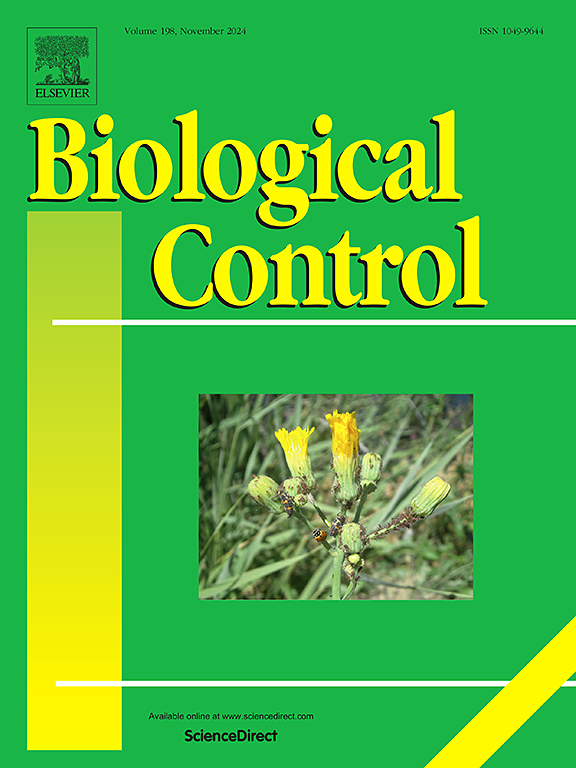A novel Arthrobotrys species: Taxonomic characterization, nematicidal activity, and multi-omics insights into nematode predation
IF 3.4
2区 农林科学
Q2 BIOTECHNOLOGY & APPLIED MICROBIOLOGY
引用次数: 0
Abstract
Bursaphelenchus xylophilus, the pinewood nematode (PWN), is a devastating invasive pest responsible for widespread mortality in global conifer forests. During a survey of bark beetle-associated fungi, a nematode-trapping fungus was isolated from an empty beetle gallery in Pinus thunbergii. ITS sequence analysis suggested it represented a novel species. This study aimed to characterize the fungus taxonomically and evaluate its biocontrol potential against PWN. Multi-locus phylogenetic analyses (ITS, TEF1-α, RPB2) confirmed the isolate as a new species, Arthrobotrys byssisimilis sp. nov. Morphological examination revealed adhesive trapping networks and distinctive ellipsoidal conidia. Enzymatic assays demonstrated chitinase and protease activity, with optimal conditions defined for pH and temperature. Culture filtrates, protein extracts, and secondary metabolites showed rapid, dose-dependent nematicidal effects, achieving 100 % PWN mortality within 10–30 min. The fungus exhibited strong tolerance to pine-derived volatiles (α-pinene, β-pinene, turpentine, and ethanol), indicating high adaptability to the host environment. Whole-genome sequencing revealed a 36.97 Mb genome with 8,354 predicted genes, including 104 proteases, 8 chitinases, and diverse secondary metabolite biosynthesis clusters. Transcriptomic profiling after nematode exposure identified 638 differentially expressed genes, including virulence-related enzymes (proteases, CAZymes), cytochrome P450s, and PHI factors, with evidence of stage-specific regulation. Arthrobotrys byssisimilis is the first Arthrobotrys species reported from a bark beetle gallery, expanding the ecological scope of the genus. The integrated in vitro nematicidal activity, physiological adaptability, and multi-omics data suggest A. byssisimilis warrants further evaluation as a potential biocontrol agent against PWN, while its unique genomic features provide new molecular targets for investigating fungal-nematode interactions.
一个新的节肢动物物种:分类特征、杀线虫活性和多组学对线虫捕食的见解
松材线虫(Bursaphelenchus xylophilus)是造成全球针叶林广泛死亡的破坏性入侵害虫。在对树皮甲虫相关真菌的调查中,从松的一个空甲虫画廊中分离出一种捕获线虫的真菌。ITS序列分析表明它是一个新种。本研究旨在对该真菌进行分类鉴定,并评价其对PWN的生物防治潜力。多位点系统发育分析(ITS, TEF1-α, RPB2)证实该分离物为新种Arthrobotrys byssissimilis sp. nov.形态学检查显示粘连捕获网络和独特的椭球形分生孢子。酶分析显示几丁质酶和蛋白酶活性,并确定了pH和温度的最佳条件。培养滤液、蛋白质提取物和次生代谢物显示出快速、剂量依赖性的杀线虫效果,在10-30分钟内达到100%的PWN死亡率。真菌对松树衍生挥发物(α-蒎烯、β-蒎烯、松节油和乙醇)表现出很强的耐受性,表明对宿主环境有很高的适应性。全基因组测序结果显示,该基因组全长36.97 Mb,预测基因8354个,包括104个蛋白酶、8个几丁质酶和多种次生代谢产物生物合成簇。线虫暴露后的转录组学分析鉴定了638个差异表达基因,包括毒力相关酶(蛋白酶、CAZymes)、细胞色素p450和PHI因子,并证明了阶段特异性调控。本研究首次在树皮甲虫群中发现节肢虫属,扩大了该属的生态范围。综合体外杀线虫活性、生理适应性和多组学数据表明,a . byssisimilis作为一种潜在的PWN生物防治剂值得进一步评估,而其独特的基因组特征为研究真菌-线虫相互作用提供了新的分子靶点。
本文章由计算机程序翻译,如有差异,请以英文原文为准。
求助全文
约1分钟内获得全文
求助全文
来源期刊

Biological Control
生物-昆虫学
CiteScore
7.40
自引率
7.10%
发文量
220
审稿时长
63 days
期刊介绍:
Biological control is an environmentally sound and effective means of reducing or mitigating pests and pest effects through the use of natural enemies. The aim of Biological Control is to promote this science and technology through publication of original research articles and reviews of research and theory. The journal devotes a section to reports on biotechnologies dealing with the elucidation and use of genes or gene products for the enhancement of biological control agents.
The journal encompasses biological control of viral, microbial, nematode, insect, mite, weed, and vertebrate pests in agriculture, aquatic, forest, natural resource, stored product, and urban environments. Biological control of arthropod pests of human and domestic animals is also included. Ecological, molecular, and biotechnological approaches to the understanding of biological control are welcome.
 求助内容:
求助内容: 应助结果提醒方式:
应助结果提醒方式:


